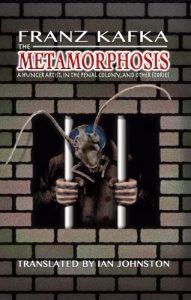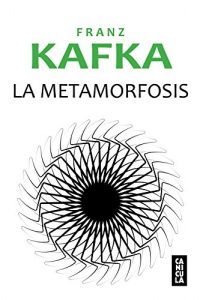Metamorphosis, A Hunger Artist, In the Penal Colony and Other Stories
Translated by Ian Johnston
Franz Kafka (1883-1924), whose writings attracted relatively little attention in his own lifetime, has long been recognized as one of the most famous, distinctive, and influential voices in modern world literature. His “Erzählungen” (stories), which are famously enigmatic, have prompted and continue to prompt a wide variety of critical debates from any number of literary schools and have stimulated interpretative adaptations of many different kinds by actors, painters, photographers, and film makers. Kafka’s fictions typically present an unusual, sometimes surreal story, in a deliberately flat prose, so that there is a wrenching gap between the weirdness, tension, humour, or horror of the events described and the apparently calm surface of the language. It is a style which at once pressures the reader to discover some allegorical structure at work in the tale, while at the same time frustrating all attempts to impose such an interpretative scheme. Hence, Kafka’s stories, which for this reason some have called “parables,” tend to remain in the reader’s imagination as vivid puzzling challenges and are very difficult to forget. The strange world Kafka depicts in his stories has given rise to the adjective Kafkaesque, which Merriam Webster defines as "having a nighmarishly complex, bizarre, or illogical quality." This new collection of stories translated by Ian Johnston includes a selection of Kafka’s best known and most popular stories, “Metamorphosis,” “In the Penal Colony,” “A Hunger Artist,” “A Report for An Academy,” “The Great Wall of China,” “Jackals and Arabs,” “Before the Law,” “Up in the Gallery,” “A Country Doctor,” “The Hunter Gracchus,” and “An Imperial Message.”
Translated by Ian Johnston
Franz Kafka (1883-1924), whose writings attracted relatively little attention in his own lifetime, has long been recognized as one of the most famous, distinctive, and influential voices in modern world literature. His “Erzählungen” (stories), which are famously enigmatic, have prompted and continue to prompt a wide variety of critical debates from any number of literary schools and have stimulated interpretative adaptations of many different kinds by actors, painters, photographers, and film makers. Kafka’s fictions typically present an unusual, sometimes surreal story, in a deliberately flat prose, so that there is a wrenching gap between the weirdness, tension, humour, or horror of the events described and the apparently calm surface of the language. It is a style which at once pressures the reader to discover some allegorical structure at work in the tale, while at the same time frustrating all attempts to impose such an interpretative scheme. Hence, Kafka’s stories, which for this reason some have called “parables,” tend to remain in the reader’s imagination as vivid puzzling challenges and are very difficult to forget. The strange world Kafka depicts in his stories has given rise to the adjective Kafkaesque, which Merriam Webster defines as "having a nighmarishly complex, bizarre, or illogical quality." This new collection of stories translated by Ian Johnston includes a selection of Kafka’s best known and most popular stories, “Metamorphosis,” “In the Penal Colony,” “A Hunger Artist,” “A Report for An Academy,” “The Great Wall of China,” “Jackals and Arabs,” “Before the Law,” “Up in the Gallery,” “A Country Doctor,” “The Hunter Gracchus,” and “An Imperial Message.”












